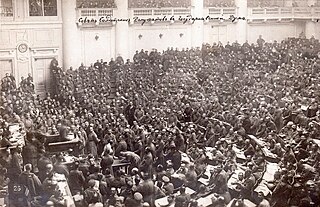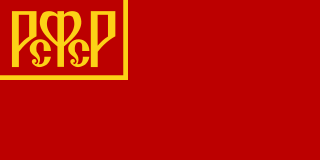Related Research Articles

The Supreme Soviet of the Union of Soviet Socialist Republics (SSUSSR) was the highest body of state authority of the Soviet Union (USSR) from 1936 to 1991. Based on the principle of unified power, it was the only branch of government in the Soviet state.

The president of the Soviet Union, officially the president of the Union of Soviet Socialist Republics, abbreviated as president of the USSR, was the head of state of the Union of Soviet Socialist Republics from 15 March 1990 to 25 December 1991.
The 1936 Constitution of the Soviet Union, also known as the Stalin Constitution, was the constitution of the Soviet Union adopted on 5 December 1936.

An index of articles related to the former nation known as the Soviet Union. It covers the Soviet revolutionary period until the dissolution of the Soviet Union. This list includes topics, events, persons and other items of national significance within the Soviet Union. It does not include places within the Soviet Union, unless the place is associated with an event of national significance. This index also does not contain items related to Soviet Military History.

A soviet is a workers' council that follows a socialist ideology, particularly in the context of the Russian Revolution. Soviets were the main form of government in the Russian SFSR and the Makhnovshchina.

The Presidium of the Supreme Soviet was the standing body of the highest body of state authority in the Union of Soviet Socialist Republics (USSR). The presidium was elected by joint session of both houses of the Supreme Soviet to act on its behalf while the Supreme Soviet was not in session. By the 1936 and 1977 Soviet Constitution, the Presidium of the Supreme Soviet served as the collective head of state of the USSR. In all its activities, the Presidium was accountable to the Supreme Soviet of the USSR.

The All-Russian Central Executive Committee was a permanent body formed by the First All-Russian Congress of Soviets of Workers' and Soldiers' Deputies, then became the supreme governing body of the Russian Soviet Federative Socialist Republic in between sessions of the All-Russian Congress of Soviets from 1917 to 1937. In 1937, the All-Russian Central Executive Committee was replaced with the Presidium of the Supreme Soviet of the Russian SFSR.

The electoral system of the Soviet Union was varying over time, being based upon Chapter XIII of the provisional Fundamental Law of 1922, articles 9 and 10 of the 1924 Constitution and Chapter XI of the 1936 Constitution, with the electoral laws enacted in conformity with those. The Constitution and laws applied to elections in all Soviets, from the Supreme Soviet of the Soviet Union, the Union republics and autonomous republics, through to regions, districts and towns. Voting was claimed to be secret and direct with universal suffrage. However, in practice, between 1936 and 1989, voters could vote against candidates preselected by the Communist Party only by spoiling their ballots, or by voting against the only candidate, whereas votes for the party candidates could be cast simply by submitting a blank ballot. A person would be given a ballot by a clerk, and could immediately walk to the ballot box, and while there were booths in which one could strike the candidates they voted against off the ballot, this was easy to record and was not commonly done by voters.

The Russian Soviet Federative Socialist Republic, previously known as the Russian Soviet Republic and the Russian Socialist Federative Soviet Republic, and unofficially as Soviet Russia, was an independent federal socialist state from 1917 to 1922, and afterwards the largest and most populous constituent republic of the Soviet Union (USSR) from 1922 to 1991, until becoming a sovereign part of the Soviet Union with priority of Russian laws over Union-level legislation in 1990 and 1991, the last two years of the existence of the USSR. The Russian SFSR was composed of sixteen smaller constituent units of autonomous republics, five autonomous oblasts, ten autonomous okrugs, six krais and forty oblasts. Russians formed the largest ethnic group. The capital of the Russian SFSR and the USSR as a whole was Moscow and the other major urban centers included Leningrad, Stalingrad, Novosibirsk, Sverdlovsk, Gorky and Kuybyshev. It was the first socialist state in history.

The Government of the Union of Soviet Socialist Republics (USSR) was the executive and administrative organ of the highest body of state authority, the All-Union Supreme Soviet. It was formed on 30 December 1922 and abolished on 26 December 1991. The government was headed by a chairman, most commonly referred to as the premier of the Soviet Union, and several deputy chairmen throughout its existence. The Communist Party of the Soviet Union (CPSU), as "The leading and guiding force of Soviet society and the nucleus of its political system" per Article 6 of the state constitution, controlled the government by holding a two-thirds majority in the All-Union Supreme Soviet. The government underwent several name changes throughout its history, and was known as the Council of People's Commissars from 1922 to 1946, the Council of Ministers from 1946 to 1991, the Cabinet of Ministers from January to August 1991 and the Committee on the Operational Management of the National Economy from August to December 1991.
Supreme Soviet elections were held in the Soviet Union on 12 December 1937. It was the first election held under the 1936 Soviet Constitution, which had formed the Supreme Soviet of the Soviet Union to replace the old legislature, the Congress of Soviets of the Soviet Union.

The Central Executive Committeeof the USSR, which may be abbreviated as the CEC, was the supreme governing body of the USSR in between sessions of the All-Union Congress of Soviets from 1922 to 1938. The Central Executive Committee elected the Presidium, which, like its parent body, was the delegated governing authority when the other was not in session. The chairman of the Presidium, served as the ceremonial head of state of the USSR. The Central Executive Committee also elected the Council of People's Commissars which was its executive and administrative organ. The Central Executive Committee of the USSR was established in 1922 by the First All-Union Congress of Soviets, and was replaced by the Presidium of the Supreme Soviet in 1938.

The All-Union Congress of Soviets was formally the supreme governing body of the Soviet Union from its formation until the adoption of its second constitution in 1936. The Congress of Soviets determined the general direction of all public bodies and elected the Central Executive Committee of the Soviet Union: a body which was accountable to, and held the powers of the Congress when the Congress was not in session. Despite its nominal authority, in practice the Congress served as a rubber-stamp for the Communist Party. With the 1936 Constitution, the All-Union Congress was replaced by the Supreme Soviet.

The All-Russian Congress of Soviets evolved from 1917 to become the supreme governing body of the Russian Soviet Federative Socialist Republic from 1918 until 1936, effectively. The 1918 Constitution of the Russian SFSR mandated that Congress shall convene at least twice a year, with the duties of defining the principles of the Soviet Constitution and ratifying peace treaties. The October Revolution ousted the provisional government of 1917, making the Congress of Soviets the sole, and supreme governing body. This Congress was not the same as the Congress of Soviets of the Soviet Union which governed the whole Soviet Union after its creation in 1922.

The Declaration and Treaty on the Formation of the Union of Soviet Socialist Republics officially created the Union of Soviet Socialist Republics (USSR), commonly known as the Soviet Union. It de jure legalised a political union of several Soviet republics that had existed since 1919 and created a new federal government whose key functions were centralised in Moscow. Its legislative branch consisted of the Congress of Soviets of the Soviet Union and the Central Executive Committee of the Soviet Union (TsIK), while the Council of People's Commissars composed the executive.
Third All-Ukrainian Congress of Soviets was a congress of Soviets (councils) of workers, peasants, Red-army-men deputies that took place in Kharkiv on March 6–10, 1919. The congress followed the Third Congress of the Communist Party of Ukraine that took place on March 1–6, 1919.
The 1938 Ukrainian Supreme Soviet elections were held in the Ukrainian SSR on 26 June 1938 to elect deputies to the Supreme Soviet. They were held alongside elections to the Supreme Soviet of the Russian SFSR as well as regular oblast councils and followed the national elections to the Supreme Soviet of the Soviet Union on 12 December 1937.

The First All-Union Congress of Soviets was a congress of representatives of Soviets of workers, peasants and Red Army deputies, held on December 30, 1922 in Moscow. The congress was attended by 2215 delegates. Kalinin was elected chairman of the congress, but Vladimir Lenin, who was not present at the congress due to illness, was elected honorary chairman of the congress. More than 90% of the delegates were members of the Russian Communist Party, 2 left-wing social federalists of the Caucasus, 1 anarchist and 1 member of the Jewish Social Democratic Party.
References
- ↑ "First Meeting, Evening, November 25, 1936" (PDF) (Transcript of the 8th Extraordinary All–Union Congress of Soviets ed.).
{{cite journal}}: Cite journal requires|journal=(help)[ permanent dead link ] - ↑ Extraordinary 8th All-Union Congress of Soviets. Verbatim Report. Bulletin No. 9 – Moscow, 1936 – Page 20